 |
 |
Our enthusiastic and extremely knowledgeable perennials team is here to answer your questions and help you choose the best perennials for your situation. There’s always something in bloom for sun, shade, butterflies, birds or deer resistance as well as a variety of bulbs for your space.
Stroll through our time-tested favorites and introduce yourself to the newest varieties. We garden with perennials too; we love them and it shows!
|
27 found, showing page 2 of 2
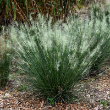
Plant Height: 3 feet
Flower Height: 4 feet
Spread: 3 feet
Sunlight: full sun, partial shade
Hardiness Zone: 5b
Other Names: Gulf Muhly
Description:
A mounding grass with very fine, glossy green foliage; airy plumes of white flowers in fall gives one a sense of fluffy clouds, that will eventually fade to tan seed pods in late fall and winter; breathtaking planted in masses
Ornamental Features:
White Cloud Muhly Grass features airy plumes of white flowers rising above the foliage from late summer to mid fall. The tan seed heads are carried on showy plumes displayed in abundance in late fall. Its glossy grassy leaves remain green in color throughout the season.
Landscape Attributes:
White Cloud Muhly Grass is a dense herbaceous perennial grass with a shapely form and gracefully arching stems. It brings an extremely fine and delicate texture to the garden composition and should be used to full effect.
This is a relatively low maintenance plant, and is best cleaned up in early spring before it resumes active growth for the season. Deer don't particularly care for this plant and will usually leave it alone in favor of tastier treats. It has no significant negative characteristics.
White Cloud Muhly Grass is recommended for the following landscape applications:
- Mass Planting
- Rock/Alpine Gardens
- General Garden Use
- Groundcover
- Container Planting
Planting & Growing:
White Cloud Muhly Grass will grow to be about 3 feet tall at maturity extending to 4 feet tall with the flowers, with a spread of 3 feet. It grows at a slow rate, and under ideal conditions can be expected to live for approximately 10 years. As an herbaceous perennial, this plant will usually die back to the crown each winter, and will regrow from the base each spring. Be careful not to disturb the crown in late winter when it may not be readily seen!
This plant does best in full sun to partial shade. It prefers dry to average moisture levels with very well-drained soil, and will often die in standing water. It is considered to be drought-tolerant, and thus makes an ideal choice for a low-water garden or xeriscape application. It is particular about its soil conditions, with a strong preference for poor, acidic soils. It is somewhat tolerant of urban pollution. This is a selection of a native North American species. It can be propagated by division; however, as a cultivated variety, be aware that it may be subject to certain restrictions or prohibitions on propagation.
White Cloud Muhly Grass is a fine choice for the garden, but it is also a good selection for planting in outdoor pots and containers. Because of its height, it is often used as a 'thriller' in the 'spiller-thriller-filler' container combination; plant it near the center of the pot, surrounded by smaller plants and those that spill over the edges. It is even sizeable enough that it can be grown alone in a suitable container. Note that when growing plants in outdoor containers and baskets, they may require more frequent waterings than they would in the yard or garden.

Height: 5 feet
Spread: 3 feet
Sunlight: full sun partial shade
Hardiness Zone: 2b
Ornamental Features:
Switch Grass features airy plumes of rose flowers rising above the foliage in mid summer. The brick red seed heads are carried on showy plumes displayed in abundance from late summer to mid fall. Its grassy leaves are green in color. The foliage often turns yellow in fall.
Landscape Attributes:
Switch Grass is an herbaceous perennial grass with an upright spreading habit of growth. Its relatively fine texture sets it apart from other garden plants with less refined foliage.
This is a relatively low maintenance plant, and is best cut back to the ground in late winter before active growth resumes. It has no significant negative characteristics.
Switch Grass is recommended for the following landscape applications:
- Accent
- Mass Planting
- General Garden Use
Planting & Growing:
Switch Grass will grow to be about 4 feet tall at maturity, with a spread of 3 feet. It tends to be leggy, with a typical clearance of 1 foot from the ground, and should be underplanted with lower-growing perennials. It grows at a medium rate, and under ideal conditions can be expected to live for approximately 15 years. As an herbaceous perennial, this plant will usually die back to the crown each winter, and will regrow from the base each spring. Be careful not to disturb the crown in late winter when it may not be readily seen!
This plant does best in full sun to partial shade. It is very adaptable to both dry and moist locations, and should do just fine under typical garden conditions. It is considered to be drought-tolerant, and thus makes an ideal choice for a low-water garden or xeriscape application. It is not particular as to soil type, but has a definite preference for alkaline soils, and is able to handle environmental salt. It is somewhat tolerant of urban pollution. This species is native to parts of North America. It can be propagated by division.
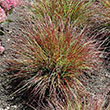
Bright red accent on blades. Compact. Tan seed heads. USDA 5-9
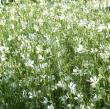
Pure white blooms. Compact. Tolerates poor soils. USDA 5-9
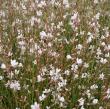
White blooms on red stems. Tolerates poor soils. USDA 5-9
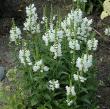
Height: 3 feet
Spacing: 30 inches
Sunlight: full sun partial shade
Hardiness Zone: 2a
Other Names: False Dragonhead
Ornamental Features:
Miss Manners Obedient Plant has masses of beautiful spikes of white hooded flowers rising above the foliage from mid summer to early fall, which are most effective when planted in groupings. The flowers are excellent for cutting. Its pointy leaves remain dark green in color throughout the
season.
Landscape Attributes:
Miss Manners Obedient Plant is an herbaceous perennial with an upright spreading habit of growth. Its medium texture blends into the garden, but can always be balanced by a couple of finer or coarser plants for an effective composition.
This is a relatively low maintenance plant, and is best cleaned up in early spring before it resumes active growth for the season. It is a good choice for attracting butterflies to your yard. It has no significant negative characteristics.
Miss Manners Obedient Plant is recommended for the following landscape applications:
- Mass Planting
- General Garden Use
Planting & Growing:
Miss Manners Obedient Plant will grow to be about 30 inches tall at maturity, with a spread of 3 feet. When grown in masses or used as a bedding plant, individual plants should be spaced approximately 30 inches apart. It tends to be leggy, with a typical clearance of 1 foot from the ground, and should be underplanted with lower-growing perennials. It grows at a medium rate, and under ideal conditions can be expected to live for approximately 10 years. As an herbaceous perennial, this plant will usually die back to the crown each winter, and will regrow from the base each spring. Be careful not to disturb the crown in late winter when it may not be readily seen! This plant does best in full sun to partial shade. It is very adaptable to both dry and moist locations, and should do just fine under typical garden conditions. It is not particular as to soil type or pH. It is highly tolerant of urban pollution and will even thrive in inner city environments. This is a selection of a native North American species. It can be propagated by division; however, as a cultivated variety, be aware that it may be subject to certain restrictions or prohibitions on propagation.
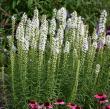
Fluffy, white flowers attract pollinators. Upright, strong stalks. USDA 3-9
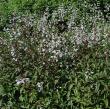
Plant Height: 18 inches
Flower Height: 30 inches
Spacing: 18 inches
Sunlight: full sun partial shade
Hardiness Zone: 3b
Other Names: Beardtongue
Ornamental Features:
Husker Red Beard Tongue has masses of beautiful spikes of white tubular flowers rising above the foliage from early to mid summer, which are most effective when planted in groupings. The flowers are excellent for cutting. Its attractive narrow leaves emerge burgundy in spring, turning dark green in color with distinctive deep purple edges throughout the season. The deep purple stems are very colorful and add to the overall interest of the
plant.
Landscape Attributes:
Husker Red Beard Tongue is an herbaceous perennial with an upright spreading habit of growth. Its medium texture blends into the garden, but can always be balanced by a couple of finer or coarser plants for an effective composition.
This is a relatively low maintenance plant, and is best cleaned up in early spring before it resumes active growth for the season. It is a good choice for attracting butterflies and hummingbirds to your yard. It has no significant negative characteristics.
Husker Red Beard Tongue is recommended for the following landscape applications:
- Mass Planting
- Border Edging
- General Garden Use
- Container Planting
Planting & Growing:
Husker Red Beard Tongue will grow to be about 18 inches tall at maturity extending to 30 inches tall with the flowers, with a spread of 24 inches. When grown in masses or used as a bedding plant, individual plants should be spaced approximately 18 inches apart. It grows at a fast rate, and under ideal conditions can be expected to live for approximately 10 years. As an herbaceous perennial, this plant will usually die back to the crown each winter, and will regrow from the base each spring. Be careful not to disturb the crown in late winter when it may not be readily seen!
This plant does best in full sun to partial shade. It prefers dry to average moisture levels with very well-drained soil, and will often die in standing water. It is considered to be drought-tolerant, and thus makes an ideal choice for a low-water garden or xeriscape application. It is not particular as to soil type or pH. It is somewhat tolerant of urban pollution. This is a selection of a native North American species. It can be propagated by cuttings; however, as a cultivated variety, be aware that it may be subject to certain restrictions or prohibitions on propagation.
Husker Red Beard Tongue is a fine choice for the garden, but it is also a good selection for planting in outdoor pots and containers. With its upright habit of growth, it is best suited for use as a 'thriller' in the 'spiller-thriller-filler' container combination; plant it near the center of the pot, surrounded by smaller plants and those that spill over the edges. Note that when growing plants in outdoor containers and baskets, they may require more frequent waterings than they would in the yard or garden.
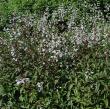
White blooms. Dense maroon and green foliage. Clumping. USDA 3-8
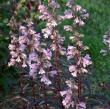
Tubular shaped white flowers cover the tops of erect blooming stems, standing tall over top of clumping mounds of lance-shaped dark green leaves. Height 3-4'.
Penstemon attracts bees, butterflies and hummingbirds to the garden. Prefers average, dry to medium well drained soil. Avoid wet poorly drained soil as it will rot. Drought tolerate when established. Deer and rabbit resistant.
- USDA Hardiness Zone(s): 3-8
- Exposure: Full Sun, Part Shade
- Bloom Time(s): April-June
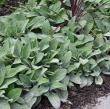
Silvery green foliage. Flowering stems are rare. USDA 4-9
27 found, showing page 2 of 2




